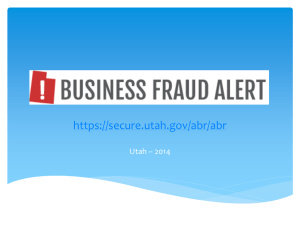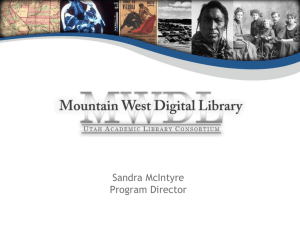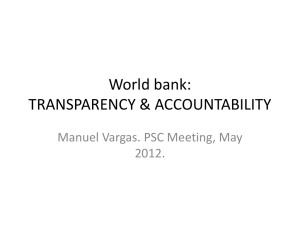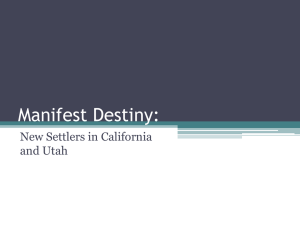Transparency in Government - Utah Municipal Clerks Association
advertisement
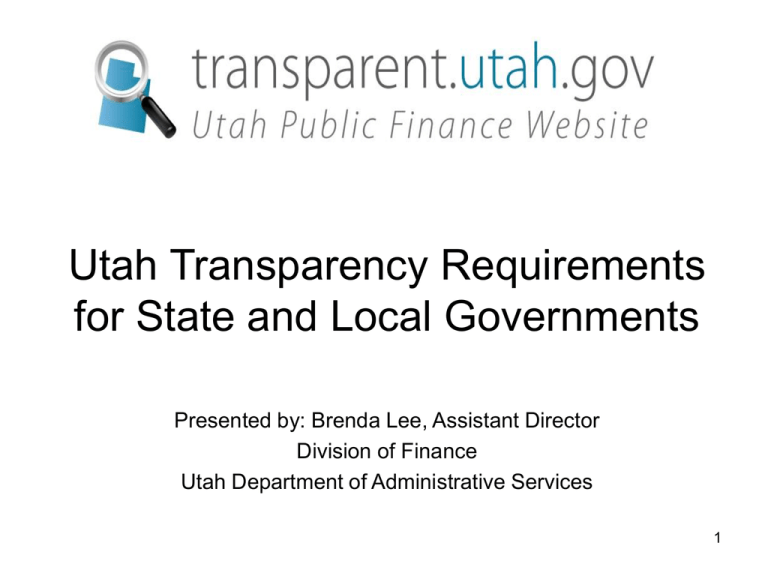
Utah Transparency Requirements for State and Local Governments Presented by: Brenda Lee, Assistant Director Division of Finance Utah Department of Administrative Services 1 THE MESSENGER REQUESTS THAT SHE PLEASE NOT BE SHOT. THANK YOU! 2 “The other day I got out my can opener and was opening a can of worms when I thought what am I doing?” Jack Handy 3 • UC 63A-3-402 creates the Utah Public Finance Website (UPFW) – Permit taxpayers to view, understand, and track use of taxpayer dollars on the internet without paying a fee. • Statute requires the State and Higher Ed to post financial information to UPFW. • Local governments required to post to the UPFW or their own website. • Division of Finance to establish & maintain the UPFW & coordinate & regulate posting by local entities. 4 Utah Transparency Advisory Board Permanent Members: • Chair: John Reidhead, Director Division of Finance, Department of Administrative Services • Vice Chair: Senator Wayne Niederhauser • Representative Kenneth Sumsion • Jonathan Ball, Legislative Fiscal Analyst • John Nixon, Executive Director, Governor's Office of Planning and Budget • Stephen Fletcher, CIO/Executive Director, Department of Technology Services 5 Three temporary Board Members just recently appointed by the Governor to represent the following: • Municipalities: Mia Love, Mayor, Saratoga Springs. • Counties: Bruce Larsen, Chief Deputy Auditor, Salt Lake County Auditor’s Office. (Recently resigned.) • Special & Local Districts: LeGrand Bitter, Executive Director, Utah Association of Special Districts. Their terms end June 30, 2011. 6 • Utah Transparency Advisory Board (UTAB): – Advise Finance on implementation and administration of the website. – Determine what information shall be provided with a specified content, reporting frequency, and form. – Determine search methods and criteria to be used if entity uses their own website. 7 • Utah Transparency Advisory Board (UTAB) continued: – Evaluate the cost effectiveness of providing certain information. – Establish size or budget thresholds to identify those local entities that will participate in website. – Give special consideration to those entities with an annual budget of less than $10 million. 8 • The website was operational on May 15, 2009, as required by statute. • The State posted revenues and expenses on May 15, 2009 for FY 2009. We have continued to post this information monthly. • The State posted employee compensation information in Sept 2009 and again in Sept of 2010. 9 • Must post required information by May 15, 2010: – Institutions of Higher Education (must use State’s website) – School Districts – Charter Schools – Public Transit Districts • Data posted for fiscal year that begins no later than 7/1/09 • Currently 95% of these entities have posted revenue and expense data. 10 • Required to post information by May 15, 2011: – Counties – Municipalities – Local Districts under Title 17B – Special Service Districts under Title 17D • Data posted for fiscal year that begins no later than 7/1/10 11 • Utah Transparency Board Policies: – Entities with a current annual budget of <$1 million are exempt at this time. – Based on the most recent total annual budget of either revenues or expenditures, whichever is greater. – Revenues and expenditures must be submitted at least quarterly, within one month after fiscal quarter end. 12 “ RIDE THE HORSE IN THE DIRECTION IT IS GOING.” Werner Earhard 13 • Utah Transparency Board Policies continued: – Entities must post all detail revenue and expense transactions from their accounting system including internal transactions, journal entries, vendor payments, corrections, adjustments, etc. – Website summarizes detail and allows drill down and search through the data by payee name, organization, category, and fund. – Board Policies: • www.transparent.utah.gov • Resources & Links 14 • Utah Transparency Board Policies continued: – Employee compensation data will be submitted once each year and within 3 months of fiscal year end and will include by employee: • • • • • • • • Employee name, unless protected under GRAMA Total benefits only, detail benefits not allowed Total salary/wages Total incentive awards Total leave paid (if recorded separately in entity’s system) Title Pay Rate Gender, unless protected under GRAMA 15 Employee data soon to be added: • Height • Weight • Marital status • Blood type • Just Kidding!! 16 THE MESSENGER REQUESTS THAT SHE PLEASE NOT BE SHOT. THANK YOU! 17 18 19 20 • How the State’s website works: – Entities don’t need to spend time & money developing and maintaining another website. – Each entity uploads their own files using a simple data submission process. – Separate administrative website to upload files. – Admin website is password protected. – Edits of record count and dollar amount. 21 • How the State’s website works – continued: – Finance has created a spreadsheet template which simplifies the file creation process for those entities without IT resources. If they can get data into a spreadsheet, this template can be used to create the file for the website. – Finance staff will work with each entity to help them to map their data to the website file layout. – There are 2 test websites, a display website and an upload website. 22 • How the State’s website works – continued: – Test websites allow for upload of files in a safe test environment. – Test websites are password protected, not public websites. – Ability to view data on test website and work through issues. 23 • How the State’s website works – continued: – Ability to delete and re-add test files. – Flexible data structure, fields can be customized for each entity. – Pipe delimited text file ( | ). – Transparency Board must review and approve use of entity’s own website. 24 • Privacy Concerns – Shouldn’t send private/protected data sent to website, except for temporarily protected vendor/payee names. – GRAMA UC Title 63G Chapter 2: • Public records, • Private records, • Controlled records, • Protected records. 25 • Privacy Concerns – continued: – Federal restrictions: • HIPAA – medical information • FERPA – student information • Other state or federal statutes – Vendor names: • “Not Provided” – permanently protected • “Name Redacted” – temporarily protected – Website has an automated way to protect and unprotect vendor names. 26 • Privacy Concerns – continued: – Transaction Descriptions • Filter out private data such as: – Social security numbers – Account numbers – Welfare client names, etc. – Or use a more generic description • The State uses lowest level of category – For example: Office Supplies 27 • Demonstration of Website – Levels of Government – Entities – Transaction Types • Expense (detail from G/L) • Revenue (detail from G/L) • Payroll/Employee Compensation (employee data from payroll system) • Stimulus Expense (state use only) • Stimulus Revenue (state use only) – Fiscal Period 28 • Demonstration of Website - continued – Organization • Further defines Entity – Category • Further defines Transaction Type – Fund • Self-balancing set of accounts – Name Search • Payee/Customer/Vendor: Used for all Transaction Types 29 • Detail Transaction View – Posting Date – Website Upload Date – Entity Transaction ID – Transaction Description – Contract Description – Contract Number – Amount – Email and/or phone number contact 30 • Transaction Downloads – Ability to download into Excel spreadsheet. – Download currently limited to 10,000 records. – Larger downloads available upon request. • Possible Future Development: – Including detail payment info from subsidiary payment systems such as MMIS (Medicaid), PACMIS (Dept of Human Services), etc. – Loading more contract information and copies of contracts. 31 • Contacts at Finance: – Darrell Swensen (functional) • dwensen@utah.gov • 801-538-3059 – Mary Lee Hickey (technical) • mhickey@utah.gov • 801-538-3273 – Brenda Lee (project manager) • brendalee@utah.gov • 801-538-3102 32


